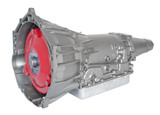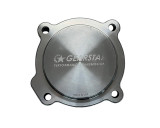Why the GM 4L75E Transmission is a Top Choice for Performance Enthusiasts
The GM 4L75E transmission is a high-performance automatic transmission ideal even today for car enthusiasts seeking durability and power. Enhanced to handle greater torque and horsepower than its predecessors, the 4L75E combines reliability with improved shift response in a relatively small package.
When pushing your car to its limits, your transmission can be the weakest link, leading to poor performance and breakdowns under stress. It doesn’t matter what your engine can output if your gearbox can’t handle it. A subpar transmission will buckle under the increased torque, robbing your vehicle of the performance it deserves and risking costly repairs.
The 4L75E transmission is a high-performance automatic transmission from General Motors, designed for drivers who require durability and performance for both everyday needs and demanding high-performance-oriented applications. An evolution of GM's iconic 4L60 and 4L70 transmission series, the 4L75E was engineered with enhanced strength, torque capacity, and reliability, especially for trucks, SUVs, and performance vehicles.
Overview of the GM 4L75E Transmission
GM introduced the 4L60 transmission series in the early 1980s, and through decades of refinement, it evolved to meet rising demands for performance, efficiency, and durability. The 4L75E, which builds on the legacy of the 4L60 and 4L65 series, offers considerable upgrades and improvements over its predecessors while remaining smaller and lighter than the 4L80E, making it an excellent choice even today for builds with less space.
Developed in response to a demand for better handling of high-power engines, the 4L75E is a high-capacity, electronically controlled four-speed automatic transmission introduced with significant enhancements to support larger engines and increased vehicle loads without sacrificing smoothness in shifting. The part number for the 4L75E transmission is crucial for ordering and ensuring compatibility with specific vehicle models.
Why the 4L75E Is Ideal for Performance Enthusiasts
Designed to withstand the high stress of performance driving, the 4L75E’s reinforced components allow it to handle big torque loads without compromising its longevity. This durability is particularly advantageous for muscle car restorations, racing, and custom builds.
The transmission is built to manage heat better, reducing the risk of overheating even during prolonged heavy usage. The 4L75E is designed for vehicles equipped with high-torque engines. This is a major plus for high-performance and towing applications, where excessive heat can reduce transmission lifespan and impact performance.
Thanks to its upgraded shift control system, the 4L75E offers seamless power delivery and reduced shifting lag. This translates to better handling on the road and a more responsive driving experience, whether for daily commuting, long highway drives, or dynamic performance driving.
Key Benefits of the 4L75E Transmission for High-Performance Applications
Increased Torque Capacity
One of the most important upgrades in the 4L75E is its higher torque capacity, making it the highest capacity choice in the range of 4L60/4L70 electronically controlled four-speed automatic transmissions. It is able to handle up to 650 lb-ft of torque. This makes it particularly suitable for heavy-duty applications and high-performance builds where previous models, such as the 4L60E, might not hold up as reliably.
Enhanced Internal Components
Rebuilt 4L75E transmissions feature hardened components, such as the input shaft and other critical internal parts. These hardened internals significantly reduce wear and tear under stress, increasing longevity.
Improved Shift Control System
The electronic shift control system in the 4L75E allows for smoother transitions between gears, which is particularly beneficial for towing and high-performance driving. This system also allows for more precise gear control, improving fuel efficiency and reducing wear on engine components.
Stronger Gear Ratios
Compared to earlier models, the 4L75E comes with optimized gear ratios that provide better control and power distribution across various driving conditions. This results in smoother acceleration, especially when towing heavy loads or accelerating from a stop.
Ideal for Engine Swaps and Modifications
For high-performance builds, the 4L75E serves as an excellent foundation that can be further enhanced through aftermarket modifications. Re-using the bell housing during a direct transmission swap is crucial for proper installation and functionality.
Installing a high-stall torque converter on the 4L75E can boost acceleration performance, making it particularly effective in racing scenarios. This allows the transmission to engage at higher RPMs, which is useful for quick take-offs.
Shift kits are another common addition. They enhance gear response times and make shifting even more aggressive, which can be advantageous for both performance driving and off-roading.
Adding an external transmission cooler can improve the transmission’s ability to handle heat in high-performance applications. Furthermore, modern transmission tuning software allows for customized shift points and torque management adjustments. This level of control will provide performance enthusiasts with the ability to adapt the 4L75E to their specific driving style and power levels.
Performance Comparison with Other GM Transmissions
There are a couple of transmissions to compare the 4L75E to from this era. The best choice always depends on your driving needs and your vehicle’s specifications. Part numbers are crucial for identifying specific transmission models and their torque ratings.
4L60E vs. 4L75E: The 4L60E is a reliable transmission but was originally designed for lighter applications, with a lower torque capacity than the 4L75E. While great for moderate power levels, it’s not ideal for high-performance or heavy-duty use. The 4L75E offers the enhanced durability and strength that the 4L60E lacks, particularly for towing, high-powered engines, and racing applications.
4L65E vs. 4L75E: Within the Chevrolet Performance lineup, the 4L75E is anticipated to offer significant performance features and improvements. While the 4L65E is an upgrade from the 4L60E, it still doesn’t match the 4L75E’s reinforced components and higher torque capacity. For those needing a transmission to handle over 600 lb-ft of torque, the 4L75E is the more robust choice, while the 4L65E is suited for moderately high-powered applications that don’t push torque limits as high.
4L80E vs. 4L75E: The 4L80E was designed for extremely heavy-duty use and has a considerably higher torque rating than even the 4L75E, making it ideal for extreme towing and industrial applications. However, the 4L75E is lighter and smaller, which may be preferable for performance applications where weight and agility are factors.
Intended Vehicle Use and Driving Style
Power is key. Drivers looking to maximize power can benefit from the 4L75E’s performance-oriented build. The 4L75E is designed for vehicles equipped with high-torque engines, enhancing its appeal for heavy-duty applications. The 4L75E’s durability and torque handling make it a great option for trucks and SUVs used for towing and other heavy-duty applications, without veering into the added pounds from building a 4L80E.
Furthermore, its reliable power handling and heat tolerance make it an excellent option for off-road enthusiasts looking to tackle rugged terrain without compromising transmission life.
Conclusion
For drivers seeking a strong, reliable, and versatile four-speed automatic transmission, the 4L75-E offers a blend of performance, durability, and adaptability that’s difficult to match. It strikes a balance between weight, torque handling, and transmission efficiency, making it an excellent fit for high-performance and heavy-duty applications alike.



